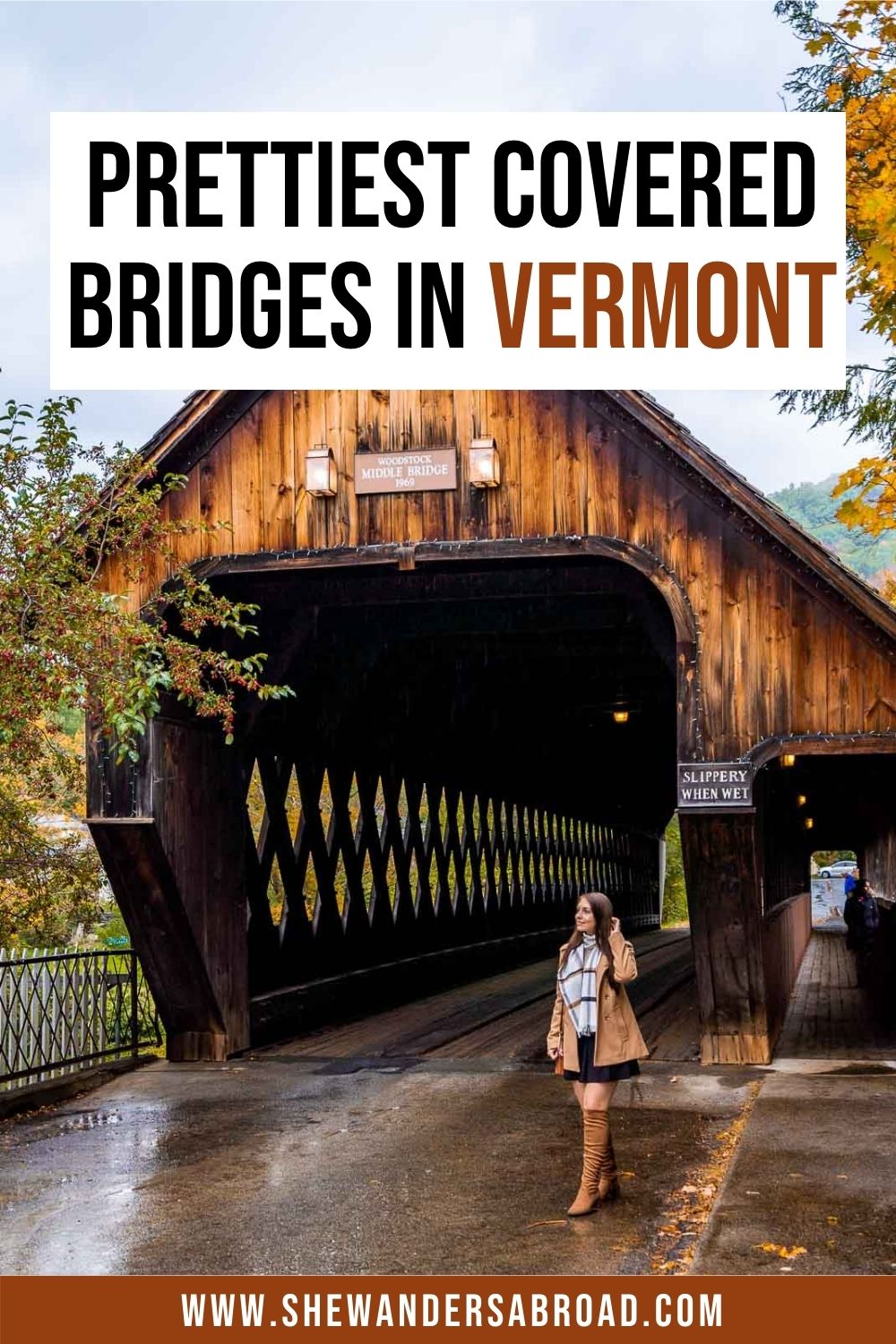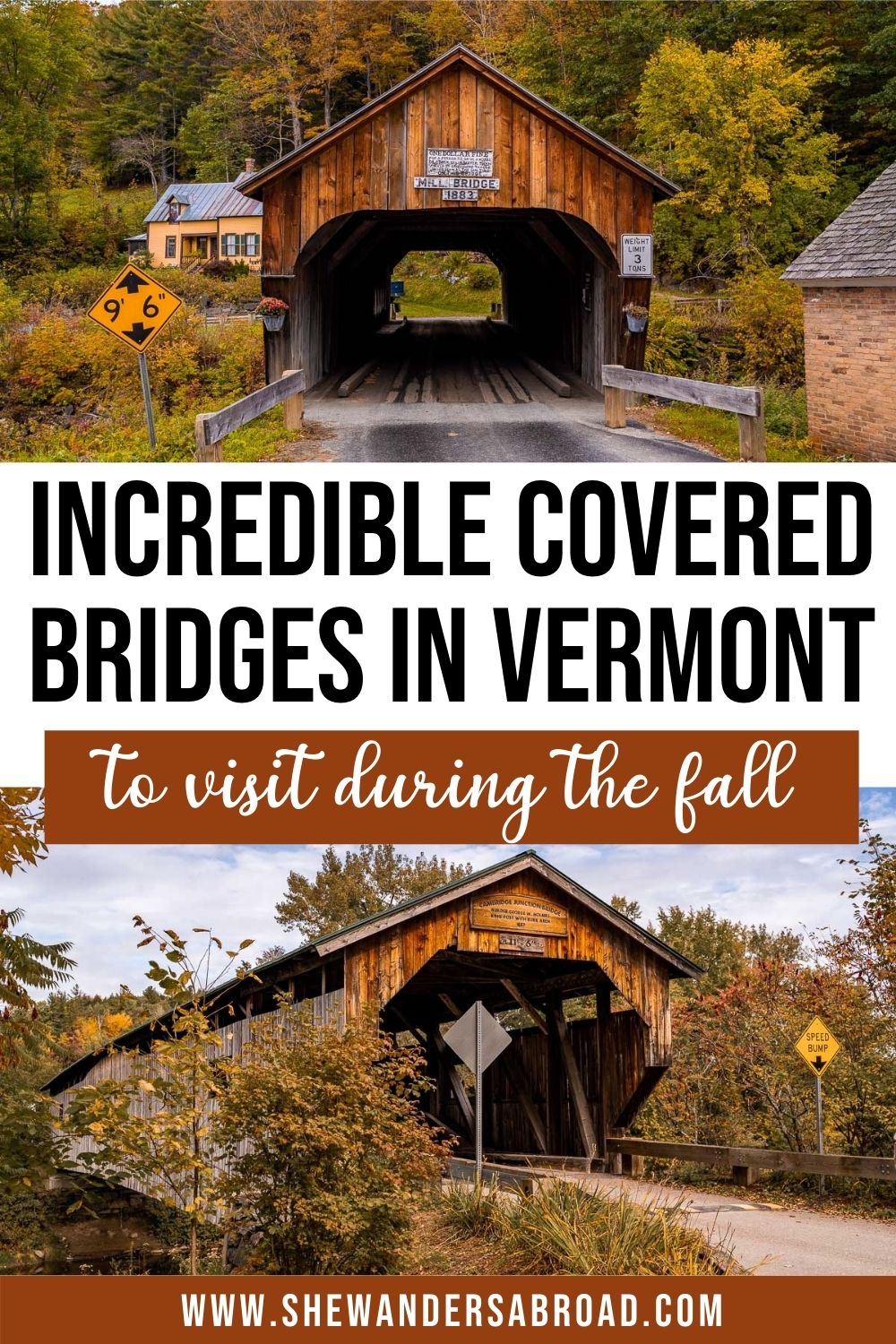Did you know that there are over 100 wooden covered bridges in Vermont? Although if you had visited the state during the late 19th century then you’ll have seen closer to 600.
These charming structures were installed for practical purposes yet those that have survived floods and other damages have become one of the kookiest attractions to check out while exploring the New England region.
Generally composed of timber and often painted a striking tone of red, they stand out against the glorious green backdrops, fall foliage, and winter wonderlands that inspire travelers to visit this northeastern region year after year.
When taking a road trip through this region of dense forestry, it can be easy to miss the bridges if you don’t already know where they are.
That’s why I’ve pieced together this guide to the 17 best covered bridges in New England. My list tells you which bridges to add to your list, how to get there, and what makes each one special.
*Disclosure: This post contains a few affiliate links, which means I may receive a small commission, at no cost to you, if you make a purchase through my link.*
Table of Contents
History of the Covered Bridges in Vermont and New England
Before spilling the beans about all the best covered bridges in Vermont, let’s start with their history, shall we?
Not only are these historic bridges unbelievably beautiful and photogenic landmarks, but they also served an important purpose in the 19th and 20th centuries.
The bridges were designed with sloping roofs as it meant that heavy rain and snowfall would simply slide into the river water beneath the structure without causing too much damage.
Although they are scattered throughout all states in the US, the state of Vermont in New England has the highest concentration in comparison to elsewhere in the country. This is perhaps due to the density of rivers running through the state and the harsher winter weather conditions.
The covered design also made it easier for farmers to transport their livestock over the bridge or for those mounted on horses more likely to feel spooked by the rivers gushing below the bridge. In snowstorms, they would also provide shelter to workers and passersby.
A vast number of the covered bridges in Vermont were constructed using locally sourced timber which helped keep the costs for materials and labor low.
Truss bridges are based on the premise of using a series of connected elements that usually form triangular units and offer stability and strength. In later decades, bridge builders chose to work with steel over timber however it is clear that inspiration was taken from the traditional wooden designs.
Evoking the charm of the state, the New England covered bridges are now a firm tourist attraction and below you can read all my tips for the ones you’ll want to add to your travel itinerary.
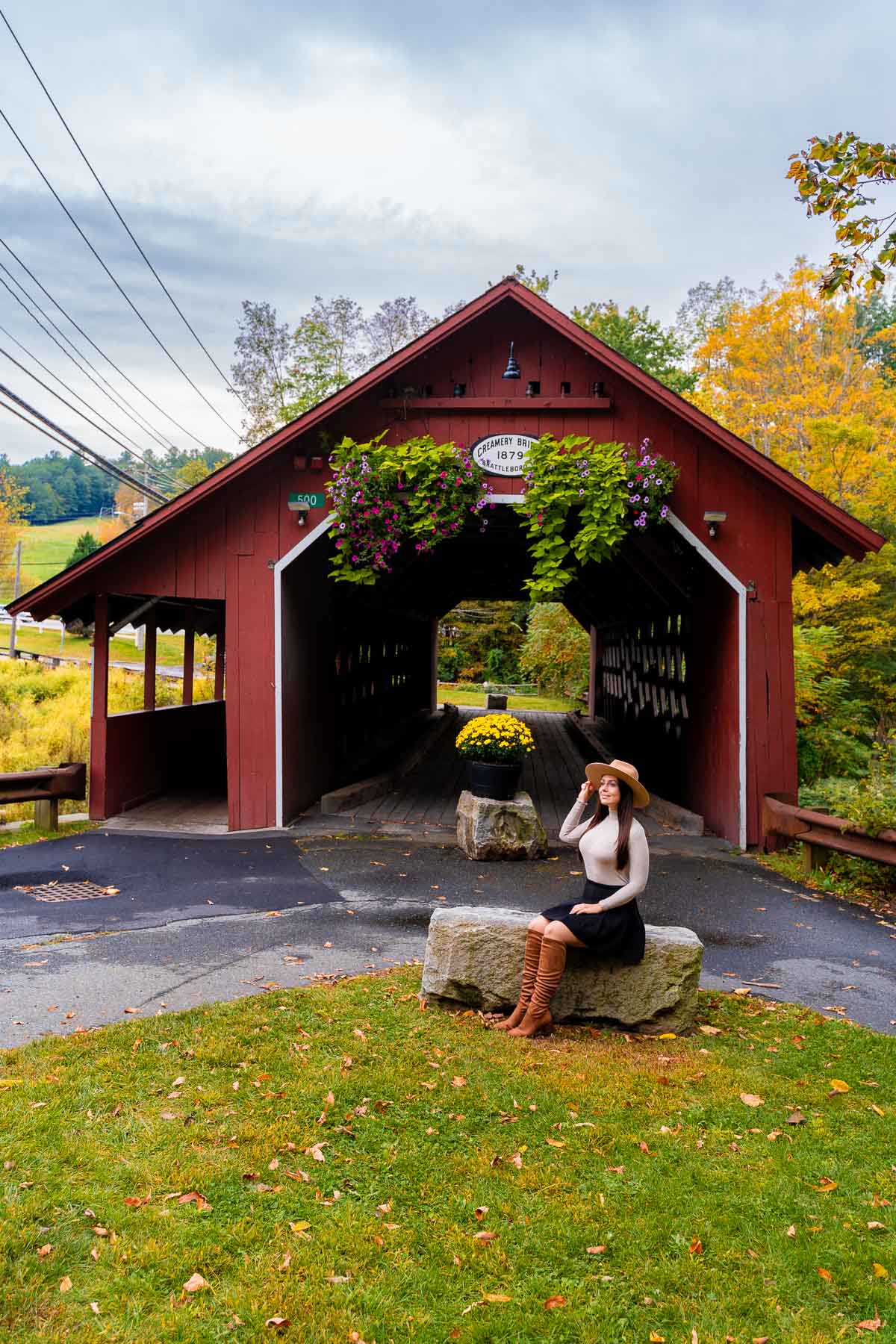
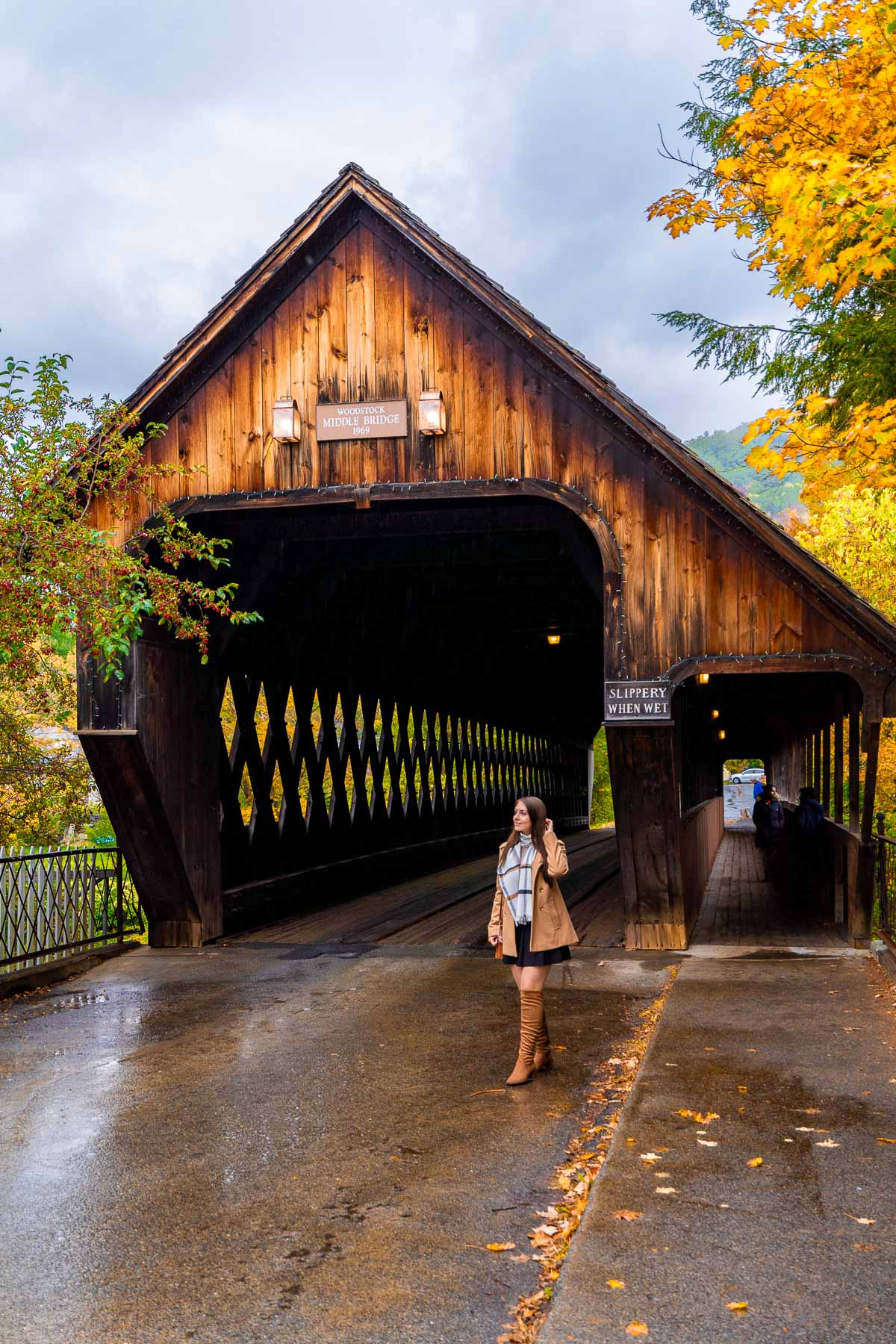
Best Covered Bridges near Woodstock VT
Woodstock is an attractive town right in the heart of the state of Vermont known for its historic buildings, outdoor pursuits, farming heritage, and its artisan community. The following covered bridges in Vermont are each located within easy driving distance of Woodstock VT.
1. Woodstock Middle Covered Bridge, Woodstock
If you’ve seen photos of only one covered bridge in Vermont then the chances are they will have been of Woodstock Middle Covered Bridge. Straddling the Ottauquechee River, the bridge is located in the town of Woodstock which is situated on Interstate Route 4.
You can park in the town and then walk to the bridge on Mountain Avenue.
The lattice truss bridge was constructed in 1969 to replace an original iron bridge. Milton Graton and his two sons used traditional bridge building methods and materials including the use of wooden pegs rather than nails.
It was the first authentic covered bridge built in the state using the truss patented by Ithiel Town in 1820. A mere five years after completion, the bridge was the subject of an arson attack, however, fortunately, it was repaired to its former glory.
The Woodstock Middle Covered Bridge remains accessible to pedestrians and vehicles. There is a separate walkway for foot passengers so that you can shoot peacefully making this one of the best covered bridges in Vermont for safety and the overall visitor experience.
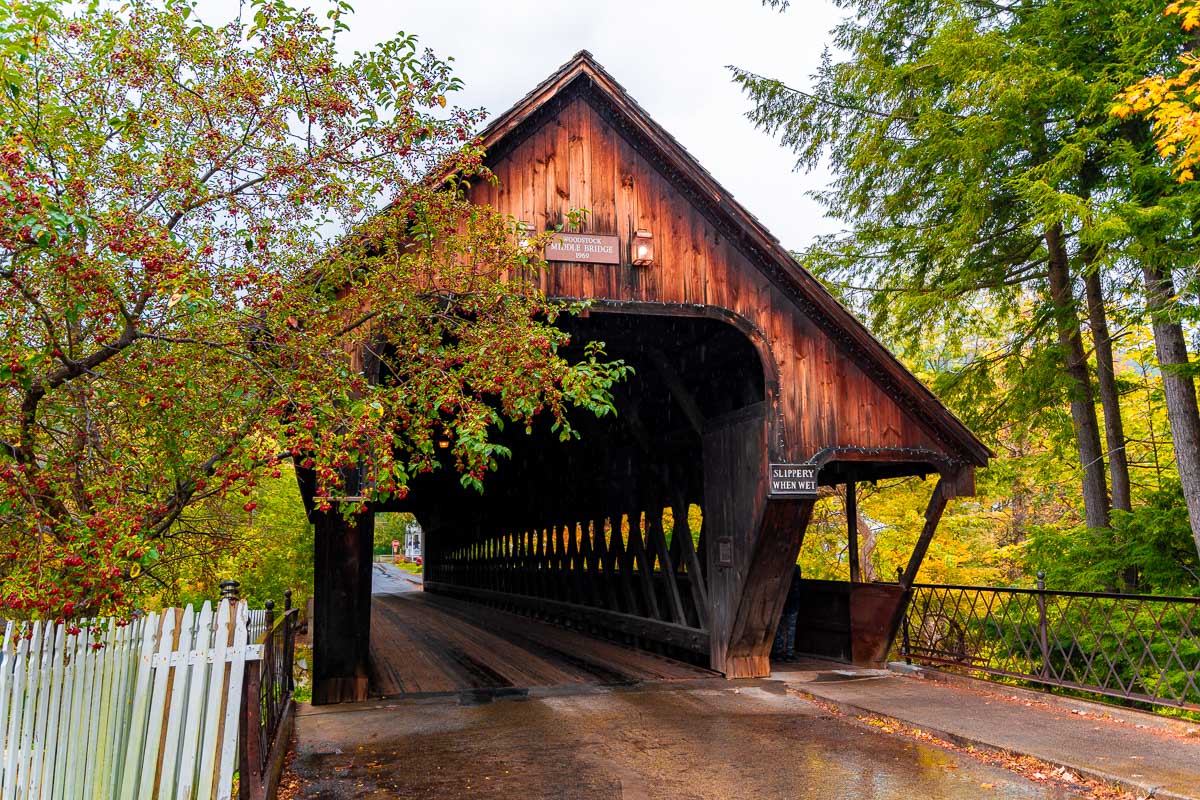
2. Taftsville Covered Bridge, Woodstock VT
Taftsville Covered Bridge is located a 5-minute drive east of Woodstock in the village of Taftsville, which is essentially an extension of Woodstock.
As with the Woodstock Middle Covered Bridge, the Taftsville Covered Bridge crosses over the Ottauquechee River on Covered Bridge Road and is accessible via the main artery, Interstate Route 4.
Solomon Emmons III was contracted to build this fox-colored bridge after three predecessors were destroyed by flooding. Completed in 1836, it is one of the oldest covered bridges in New England.
Emmons sought inspiration from further afield, perhaps European roots, for this modified multiple king post truss arched design which gives it a unique identity. Its vibrant hue looks sensational against the forested backdrop but if you visit on a snowy day then you will really note how the color pops.
Taftsville Covered Bridge is still used by car traffic. You can park in the Taftsville Historic District and walk to the bridge or you can pull over in one of the bays right before you reach it.
If you take the time to walk down to the riverside you can shoot the bridge in its entirety and get a perspective of the entire 58 meters (189 feet) of the landmark plus the waterfall that tumbles beneath it.
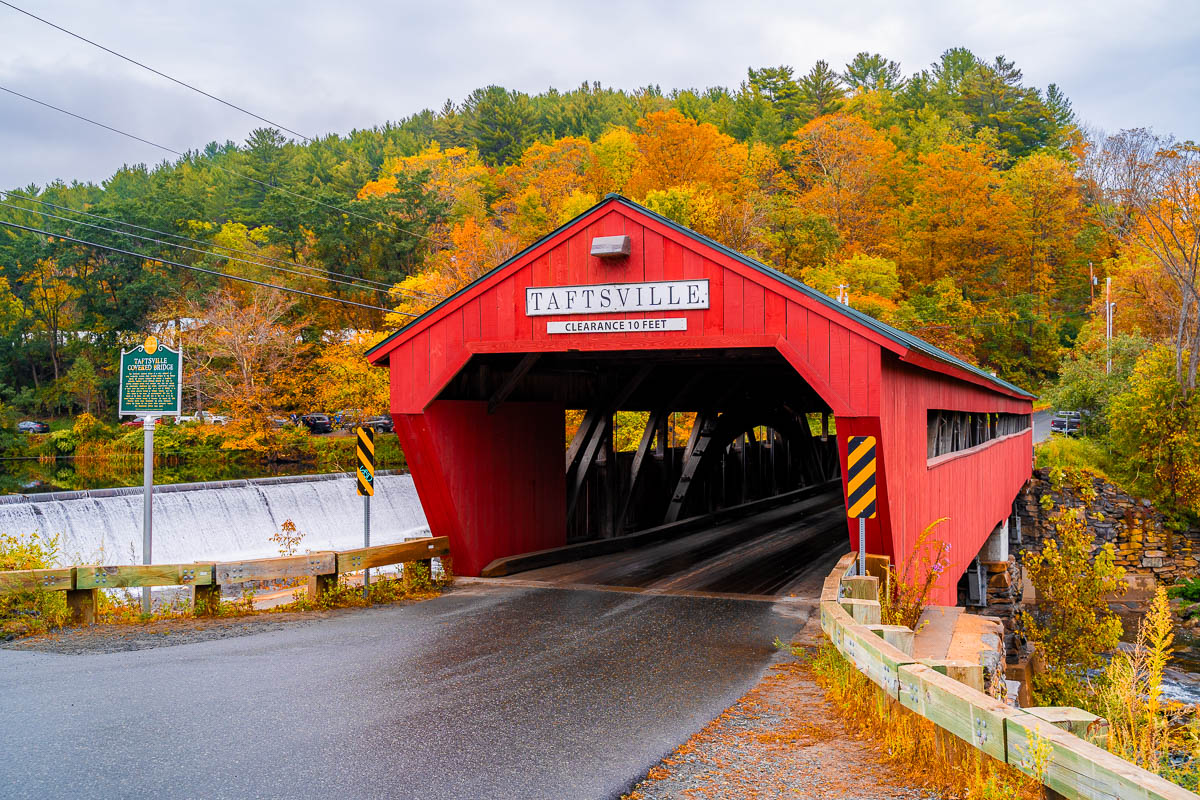
3. Lincoln Covered Bridge, Woodstock VT
The third of the Vermont covered bridges on this list to straddle the Ottauquechee River, Lincoln Covered Bridge is situated a 5-minute drive west of Woodstock.
Linking Interstate Route 4 with Bridges Road and Fletcher Hill, this is another bridge that receives a consistent flow of traffic. One of the possible parking spots is the car park at the Lincoln Inn & Restaurant at the Covered Bridge where you can pick up a meal if you need.
Constructed in 1877 by R.W. Pinney and B.H. Pinney, the Lincoln Covered Bridge was the only known wooden example of a variation of the patented Pratt truss.
The flanking arch trusses appear to have influenced the engineering of steel bridges that followed in the next century. It is now listed on the National Register of Historic Places.
As the Lincoln Covered Bridge does not feature a separate walkway for visitors on foot, it is best to drive through it, park up, and then take photos of the exterior. It’s a popular thoroughfare so keep alert while taking your photos.

4. Quechee Covered Bridge, Quechee VT
You’ll find the Quechee Covered Bridge a 5-minute drive east of the Taftsville Covered Bridge on Waterman Hill Road, just off Interstate Route 4. You can visit the first four covered bridges in Vermont within a succession of each other.
The bridge marks the entrance to the village of Quechee which is the setting for the Quechee Gorge and is also a popular destination for taking hot air balloon rides.
Constructed in 1970 and renovated as recently as 2012, Quechee Covered Bridge is one of the youngest covered bridges in New England.
While it might not be quite as visually impressive as some of the other entries on this list, once you step back and take in the structure against its backdrop of the surrounding forestry and the waterfall that cascades below, you will see why the Quechee Covered Bridge is worthy of a stop.
As well as remaining in use for road traffic, the bridge features a separate pedestrian walkway which makes it a safe spot to linger and soak up the views. There is ample parking on either side of the bridge or you can leave your vehicle in the village and walk from there.
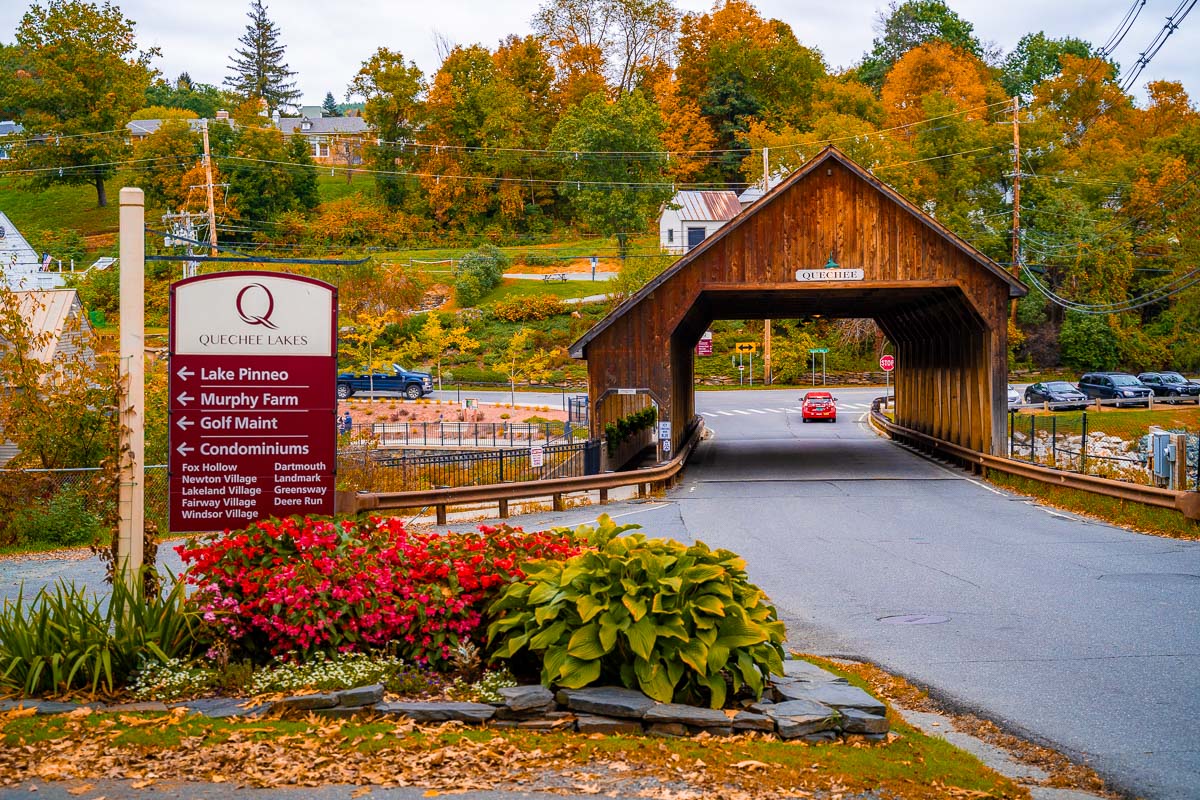
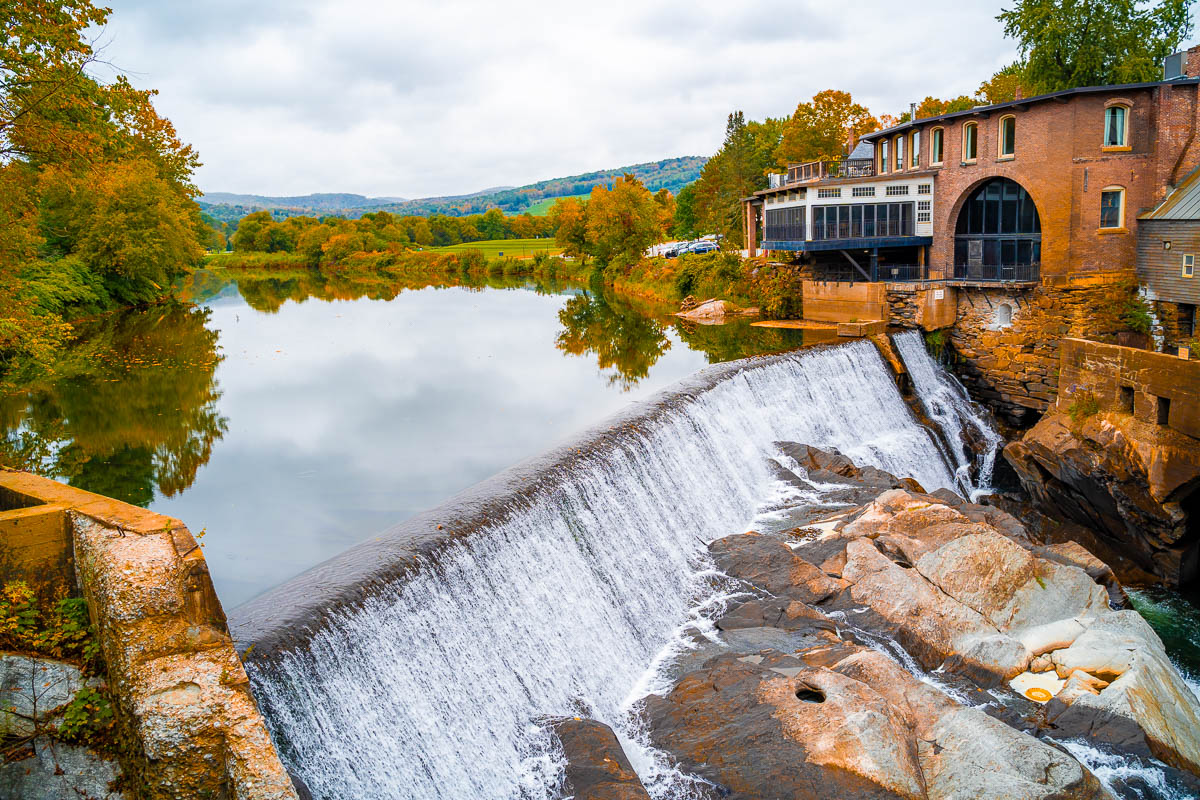
5. Cornish-Windsor Covered Bridge, Windsor VT
The Cornish-Windsor Covered Bridge connects the town of Windsor with the Cornish State Wildlife Refuge.
It’s located on the imaginatively named Bridge Street just off Interstate Route 5 and soars over the Connecticut River. This interstate bridge in fact marks the boundary of Vermont with New Hampshire.
Constructed in 1886 by Bela Jenks Fletcher, the bridge is the fourth to occupy the spot after the earlier structures were wiped out by floods. It follows the lattice truss as patented by Ithiel Town and was originally a toll bridge.
There is a sign that warns that any passers who fail to dismount their horses are subject to paying a fine!
Clocking in at an impressive 137 meters (449 feet), the Cornish-Windsor Covered Bridge is the longest covered bridge in the whole of the US.
Due to the length of the bridge, the interior is pretty dark and gloomy. Coupled with the lack of pedestrian access, you will need to take your photos from the outside. This gives you the best shots anyway, as your images will fully apprehend the length of the bridge.
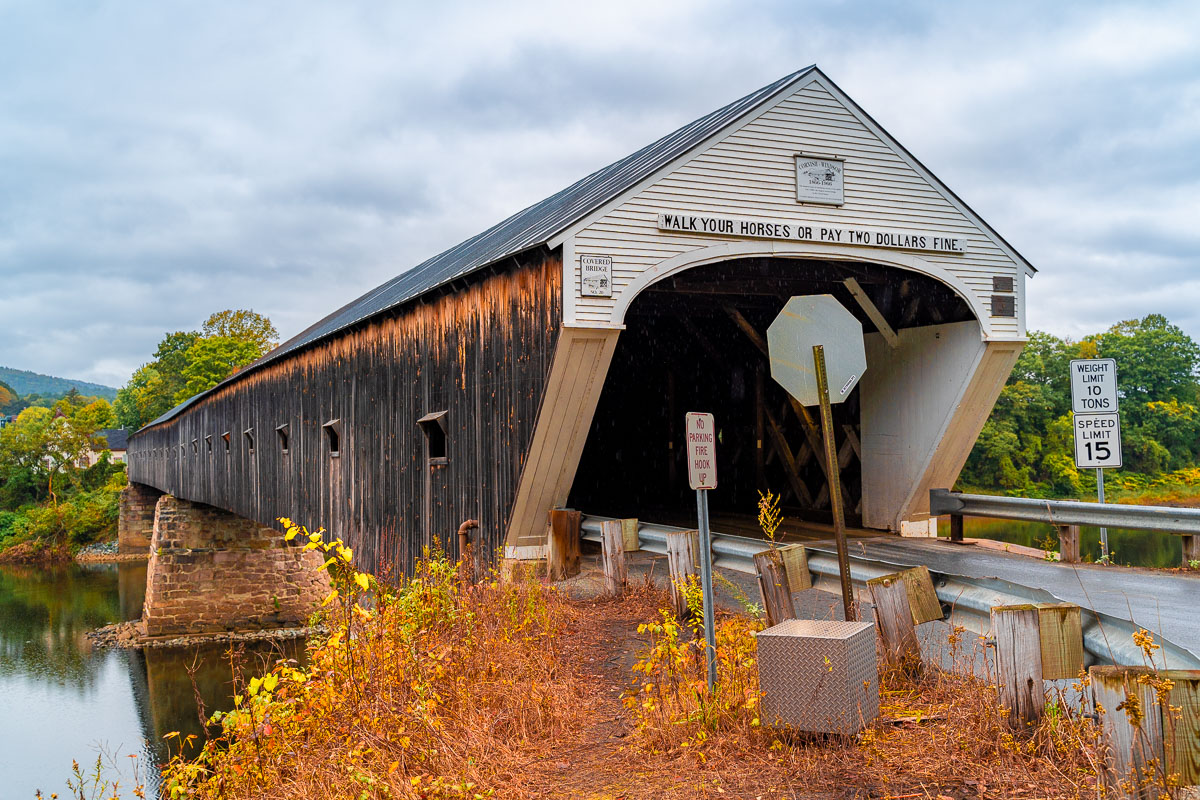
6. Unnamed Covered Bridge on Mill Brook, Hammondsville VT
This covered wooden bridge is situated a 15-minute drive south of Woodstock on the route towards Jenne Road Farm, a picturesque estate that must be the most photographed farm in the US. You can follow State Route 106 and stop just outside of Hammondsville to see the bridge.
The bridge rests atop Mill Brook, a small stream that weaves its way through the bucolic landscape. Not much is known about this bridge: it doesn’t have an official name and the year of construction is unclear but we do know that it is more than likely the private property of a local landowner.
However, if you’re passing through then it’s worth stopping off to appreciate it from afar, particularly if you’re planning a stop at Jenne Road Farm to see the iconic red outhouses.
As the bridge is not public property, it is not possible to drive or walk through it. Please respect the owner and take your photos from a distance.
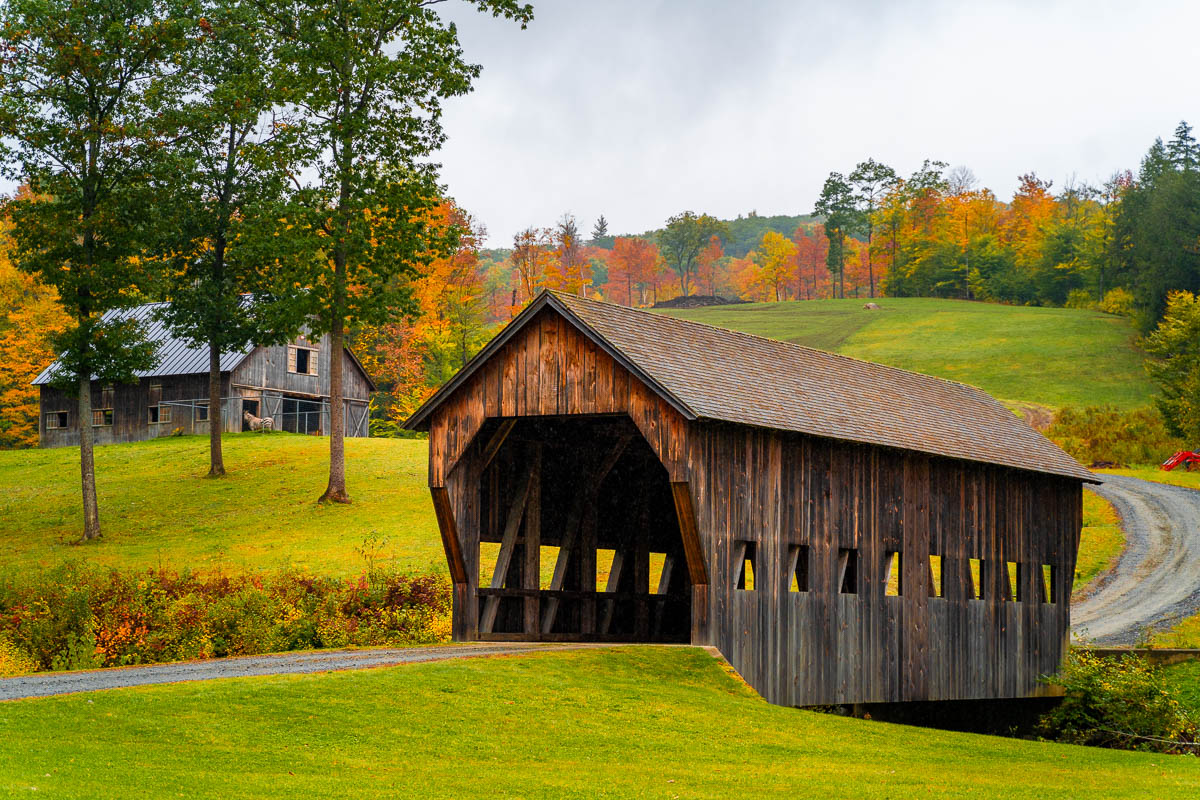
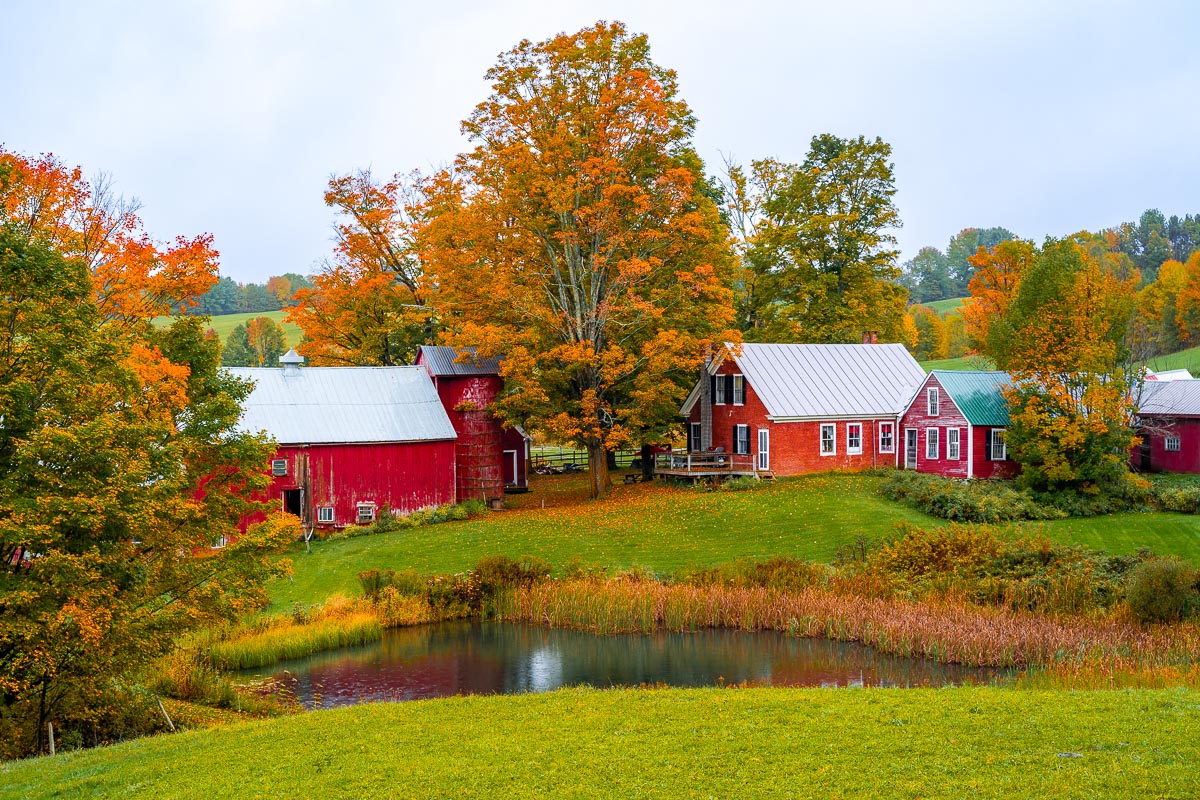
Best Covered Bridges near Stowe VT
Heading further north of Woodstock, Stowe sits at the base of Mount Mansfield and provides access to the neighboring ski slopes. Although touted as the Ski Capital of the East, the city has year-round appeal and gives you easy access to some of the best covered bridges in Vermont.
Visiting the covered bridges is definitely one of the top things to do in Stowe so definitely don’t miss them!
7. Giles W. Dewey Memorial Bridge, Stowe VT
The Giles W. Dewey Memorial Bridge is located on Mountain Road in the northern Vermont town of Stowe. Crossing over Little River, the bridge is a short walk from the town center.
It is dedicated to Giles W. Dewey, a local farmer, politician, and philanthropist who passed away in 2000. This bridge varies from the others on this list as rather than spanning the entire road, the roof just covers the pedestrian walkway.
You can park your car and then take your time meandering your way over the river snapping photos and relishing the scenery. The external side of the walkway is open to the elements which means that your view is unhindered.
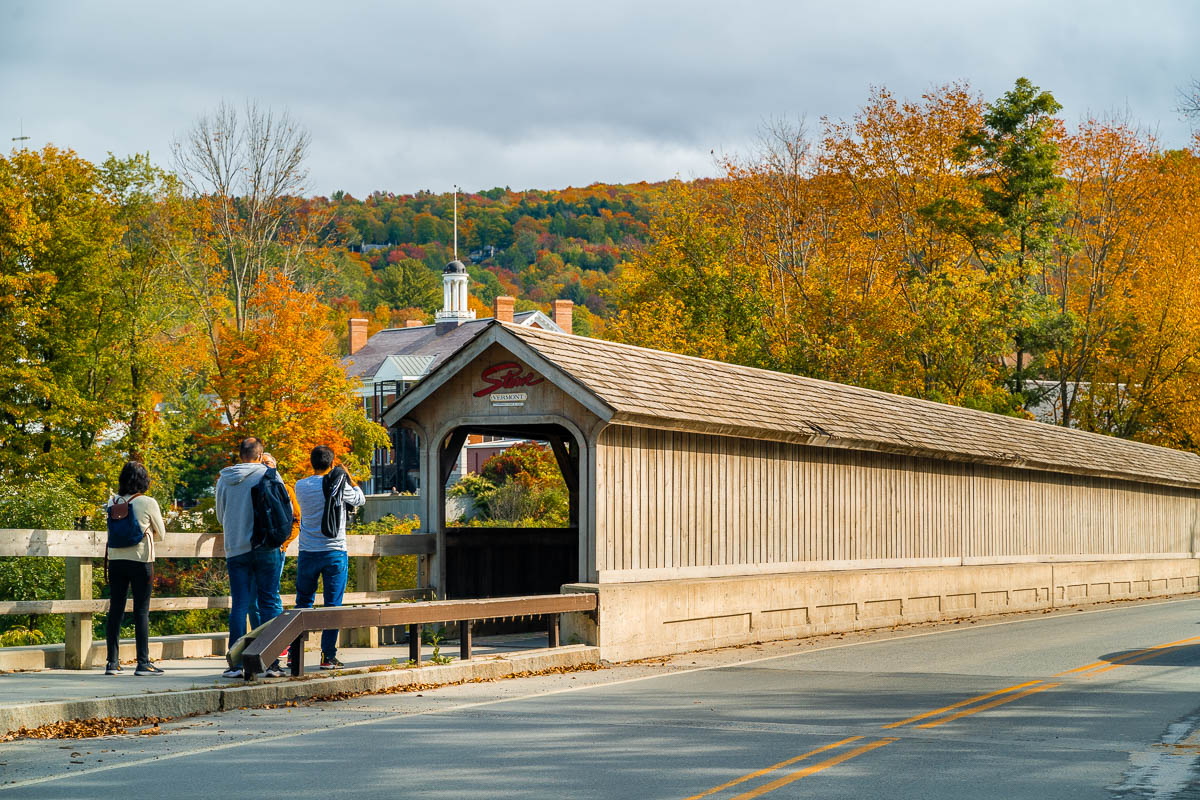
8. Gold Brook Covered Bridge, Stowe VT (Emily’s Bridge)
Officially the Gold Brook Covered Bridge, this one is more commonly known as Emily’s Bridge or the Stowe Hollow Bridge. Situated a 5-minute drive south of the town of Stowe, it sweeps Covered Bridge Road over Gold Brook which flows below the structure.
Built in 1844 by John W. Smith, Gold Brook Covered Bridge is the only surviving 19th-century covered bridge in the town of Stowe. If you’re visiting Vermont in the fall, you can’t miss this bridge!
It’s also one of the only covered bridges in Vermont with a resident ghost.
The nickname, Emily’s Bridge, stems from a fable about a young woman from the 1850s who fell in love with a local man. His wealthy parents dashed their hopes to marry as they disapproved of Emily coming from a poor family.
When, after the lovers planned to elope and the man did not show up at the meeting spot, Emily took her own life by leaping from the bridge into the brook, leaving her ghost behind to haunt the platform.
You can park your car next to the bridge and take a closer look at the structure before driving through and getting on your way. However, the structure is narrow so stay alert for incoming traffic and do not cross through it on foot (or at least be very careful).
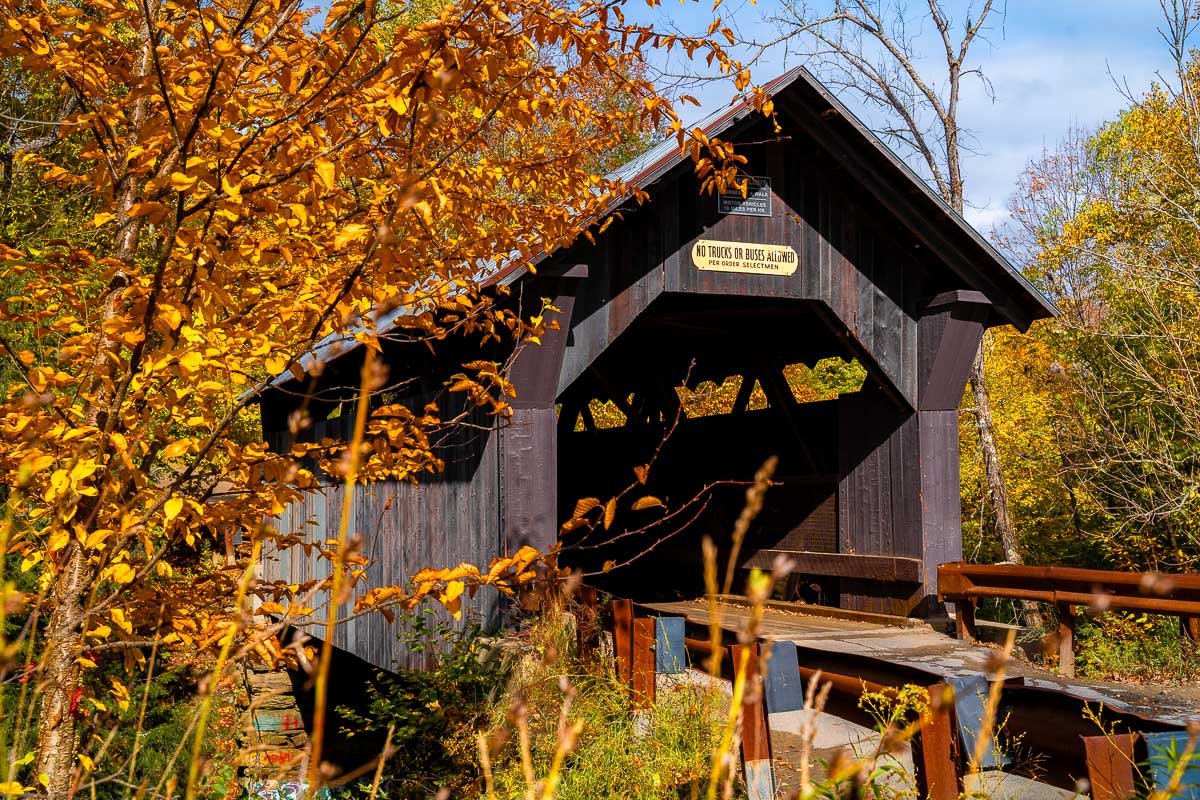
9. Cambridge Junction Bridge, Cambridge VT
The Cambridge Junction Bridge is located in the village of Jeffersonville and forms an extension to the town of Cambridge. Follow State Route 15 eastbound and turn off onto Cambridge Junction Road which crosses the Lamoille River. It takes 10 minutes to drive there from Cambridge.
Also known as the Poland Covered Bridge, the Cambridge Junction Bridge is the work of George W. Holmes who built it in 1887 following the Burr arch-truss specification.
Over the first one hundred years, the bridge began to lean. A collision in the 1990s solved the problem but led to other structural issues and so the bridge went under a major reconstruction in 2003. During the remodel, rails were added to help combat further damage from tires knocking the Burr arches.
It is not safe to walk through the Cambridge Junction Bridge on foot due to how narrow the interior is. However, you can park on either side of it if you want to take photos and get a closer look.
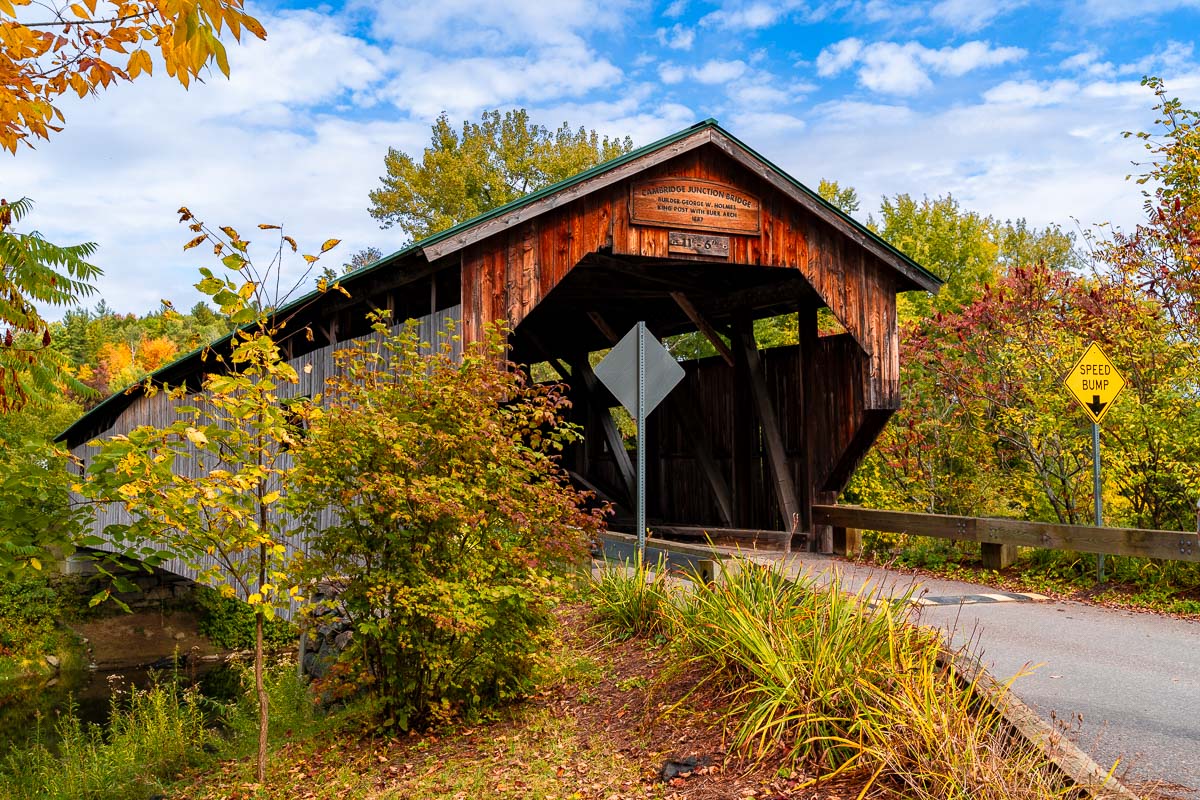
10. Grist Mill Covered Bridge, Jeffersonville VT
The Grist Mill Covered Bridge is situated just off State Route 108, connecting Grist Mill Drive with Canyon Road over the Brewster River. It also goes by the names of the Scott Covered Bridge, the Bryant Covered Bridge, and even the Canyon Covered Bridge.
This is one of the New England covered bridges where little is known about the engineer and the time of construction. It was named for the old grist mill building which is nearby while a rumor has it that someone called Scott may have been the builder of the bridge.
There is ample parking on either side of the bridge so you can enjoy a wander around the surroundings. The river itself is beautiful and the old grist mill is impressive if you want to get a closer look.
There is a small hiking trail that you can follow and it is also possible to take a dip in the water if you visit on a hot day. It is not advisable to walk through the covered bridge due to the narrow interior and the lack of a pedestrian walkway.
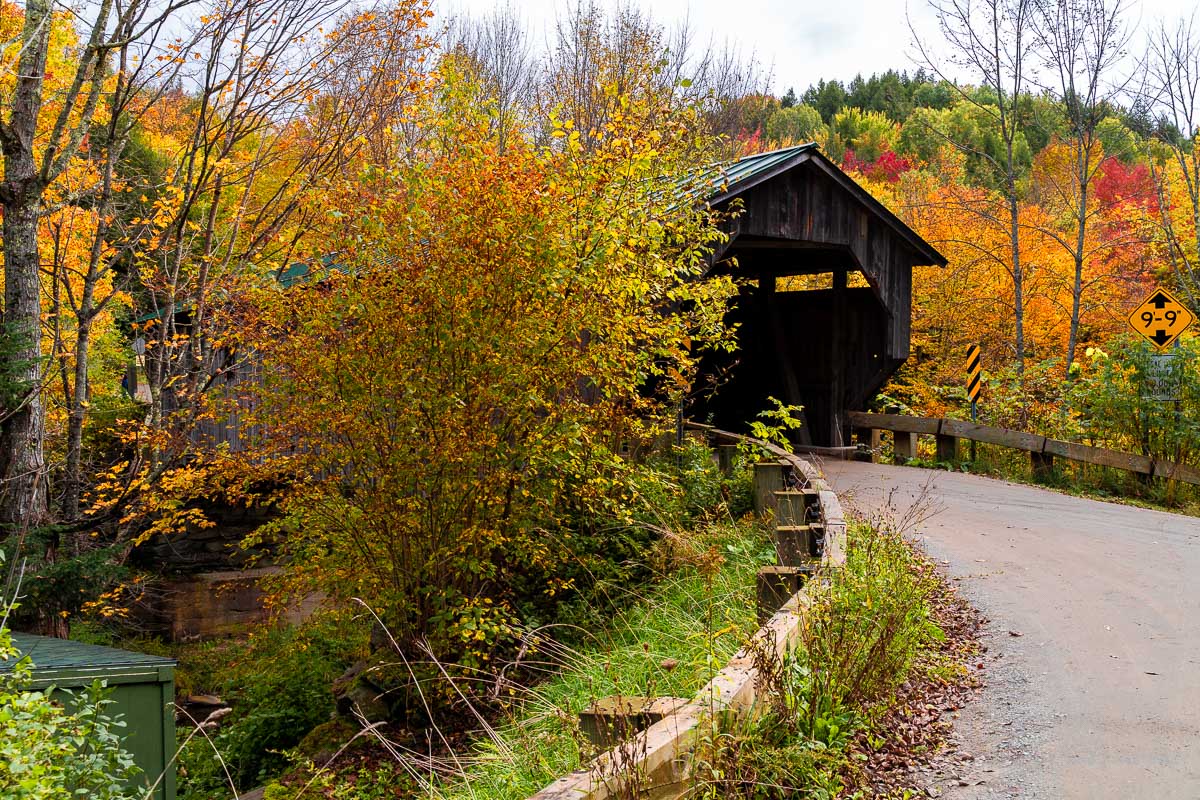
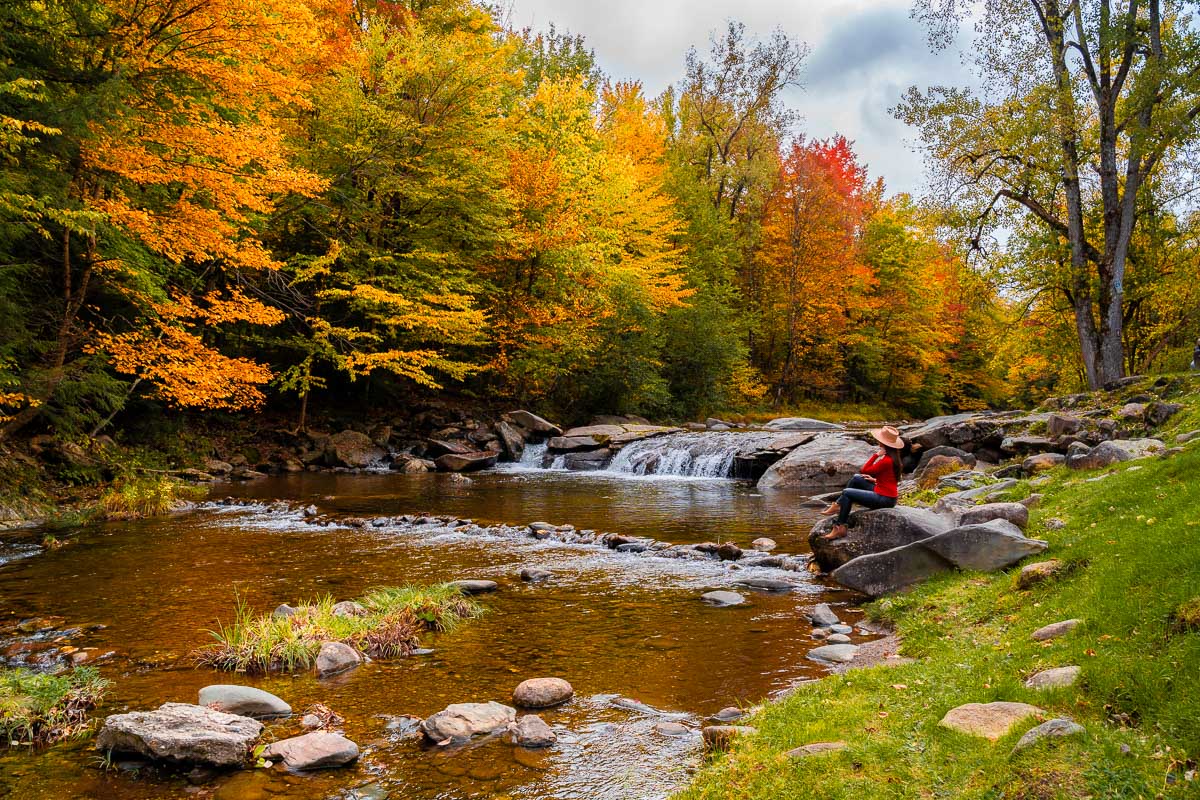
Other Great Covered Bridges in Vermont
The final 7 covered bridges in Vermont are scattered around the state. In a state that has so many of these landmarks, I’ve pulled together options where you can choose to visit the bridges in succession or slot them into your wider New England road trip itinerary.
11. Mill Covered Bridge, Tunbridge VT
The Mill Covered Bridge is located in Vermont’s Orange County, a 5-minute drive south of the town of Tunbridge. It carries Spring Road across the White River.
This bridge was constructed in 1883 by Arthur G. Adams who is credited with building a number of covered bridges in the Tunbridge area.
This is another of the Vermont covered bridges that displays a historic sign, but this time it warns those on horseback not to enter at speed.
While you’re exploring the surrounding area, pay a visit to the Hayward and Kibby Mill that stands next to the bridge and gave the structure its name. The river (and waterfall) gushes over the boulders with a force so you can get some wonderful photos at this bridge.
Inside the covered bridge, you will find two slender passageways for pedestrians and cyclists. Do take care while passing through as there is no railing between you and the oncoming vehicles.
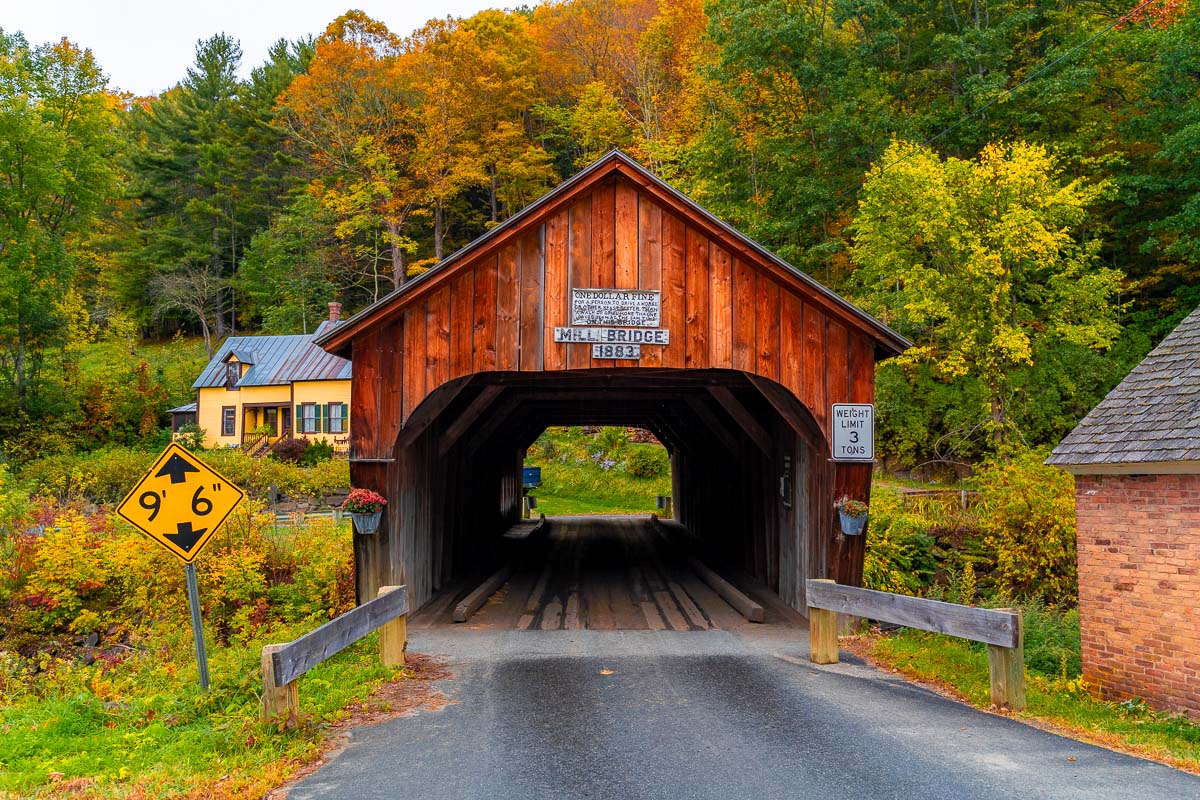
12. Cilley Covered Bridge, Tunbridge VT
The Cilley Covered Bridge is a 5-minute drive south of Tunbridge. Located just off State Route 110, it carries Howe Lane over the White River.
As the Cilley Covered Bridge was also constructed by Arthur G. Adams, you will note similarities between this one and the Mill Covered Bridge.
Both are examples of a single-span king post truss structure and are simple designs that prioritize purpose. Note how the trusses are somewhat skewed and give the bridge the shape of almost a parallelogram.
The road swerves sharply on the left bank of the river and you’ll spot some holes that help drivers see what’s ahead. For this reason, it is not recommended to walk through the bridge on foot, you’re best to park up while you explore and then drive through once finished.
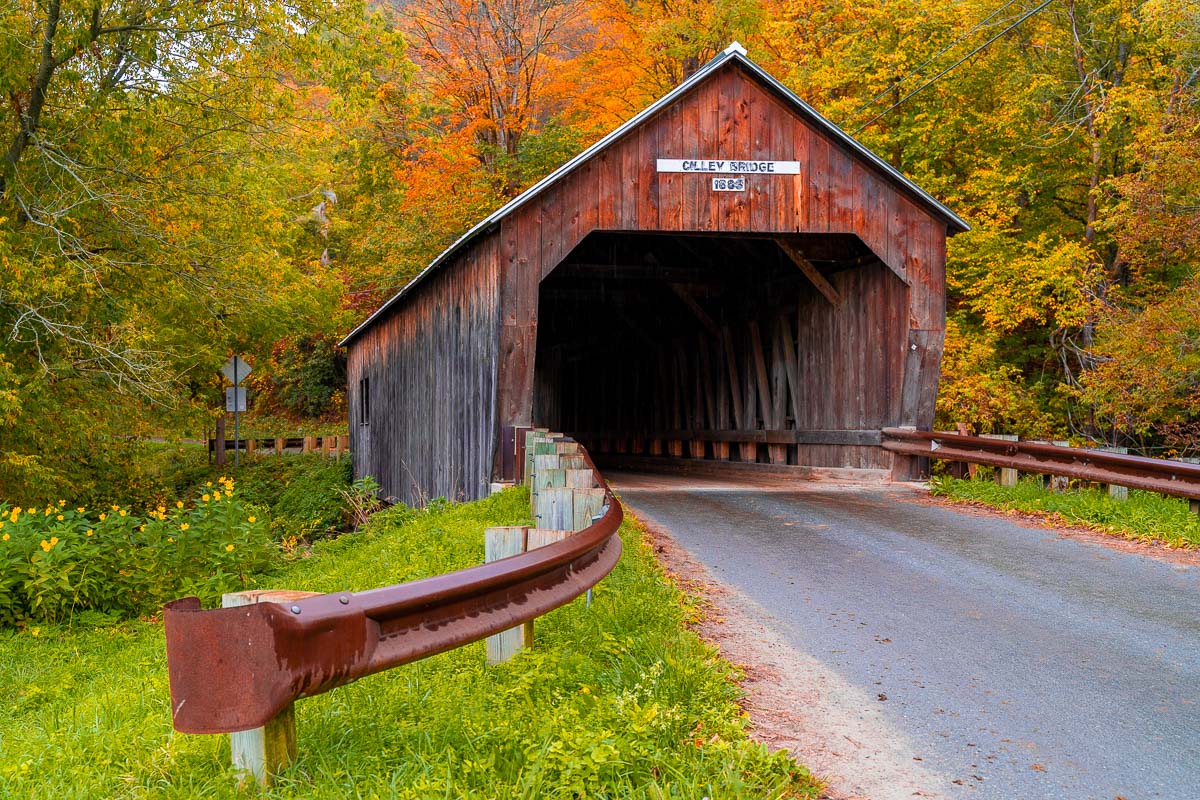
13. Howe Covered Bridge, Tunbridge VT
Access to the Howe Covered Bridge is a 10-minute drive south of Tunbridge. It carries the Belknap Brook Road across the White River just off State Route 110.
The bridge was constructed in 1879 but the builder remains unknown. It is one of two covered bridges in the state where the king post truss reaches only half the height of the bridge.
The dark timbers give the bridge a thoroughly rustic and picturesque finish and it is often decorated with flowers and wreaths.
There is no separate walkway for those on foot and so as with other Vermont covered bridges it is not recommended to linger in the bridge or cross through as a pedestrian.
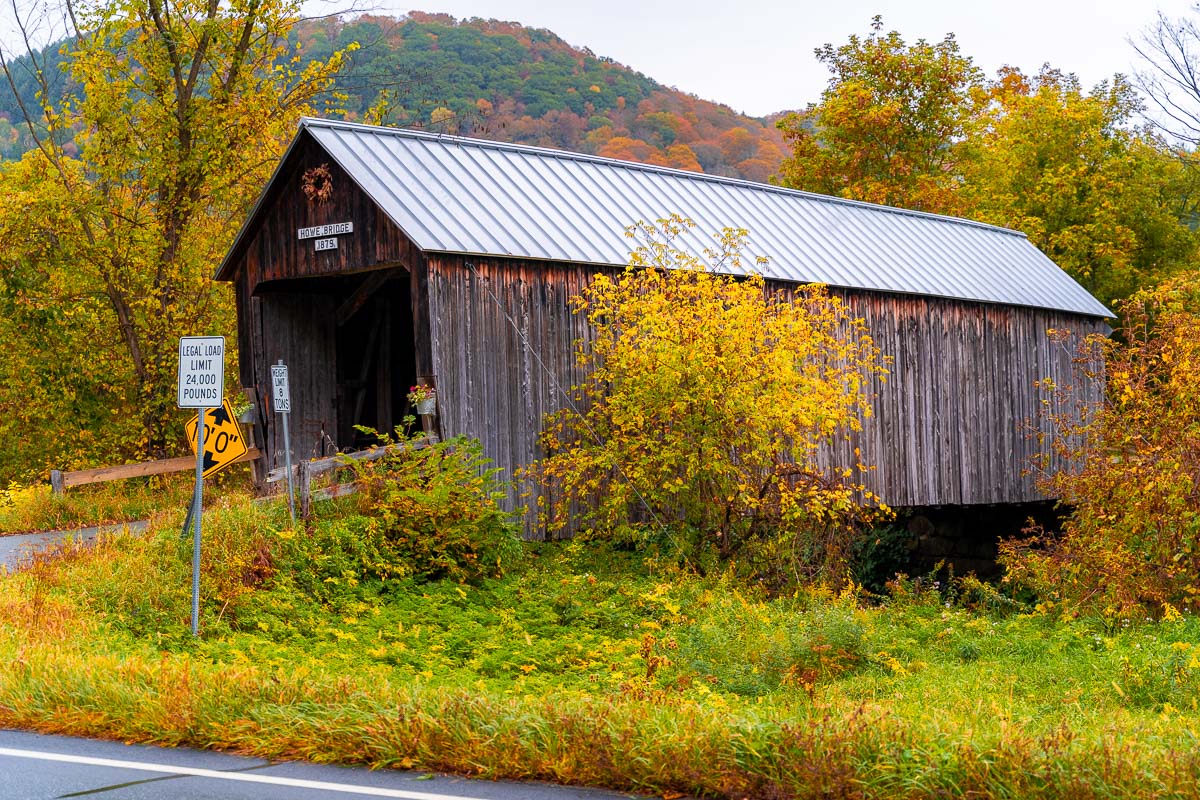
14. Kingsbury Covered Bridge, Randolph VT
The Kingsbury Covered Bridge leads Kingsbury Road across the Second Branch of the White River. It takes 15 minutes to drive there from Randolph via the State Routes 66 and 14 or 40 minutes from the state capital, Montpelier.
Built in 1904, the Kingsbury Covered Bridge is the last documented covered wooden bridge built in Vermont during this historic period.
The bridge has been through its fair share of wear and tear courtesy of harsh weather conditions including ice and flooding. Every time it has fallen into disarray, restoration has followed to keep it functional.
Again, this is a rather narrow bridge and so it is best to drive through and park on either end where you can take a stroll. With no windows on either side, the bridge is also rather dark. However, it is in a beautiful setting and you can expect to acquire some lovely shots from the exterior.
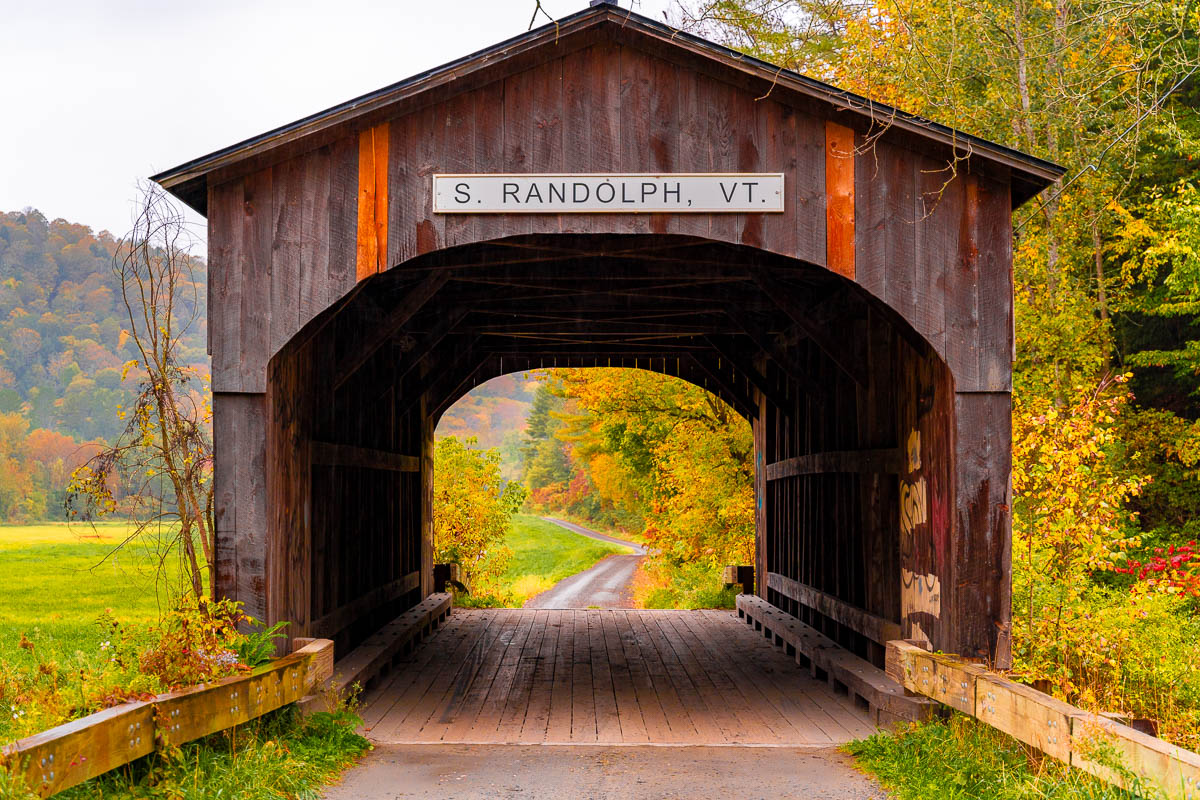
15. Braley Covered Bridge, Randolph VT
The Braley Covered Bridge passes over the Second Branch of the White River in Randolph and joins Braley Covered Bridge Road with Braley Road and Laughing Waters Way. You can drive there from Randolph via State Interstate Route 66 in around 15 minutes.
This wooden bridge is also known as the Johnson Covered Bridge and Upper Blaisdell Covered Bridge. We know that it was built in 1904 although the bridge builder is unknown.
You can pull over on either side of the bridge and then explore the area on foot and take in views of the saffron-hued bridge.
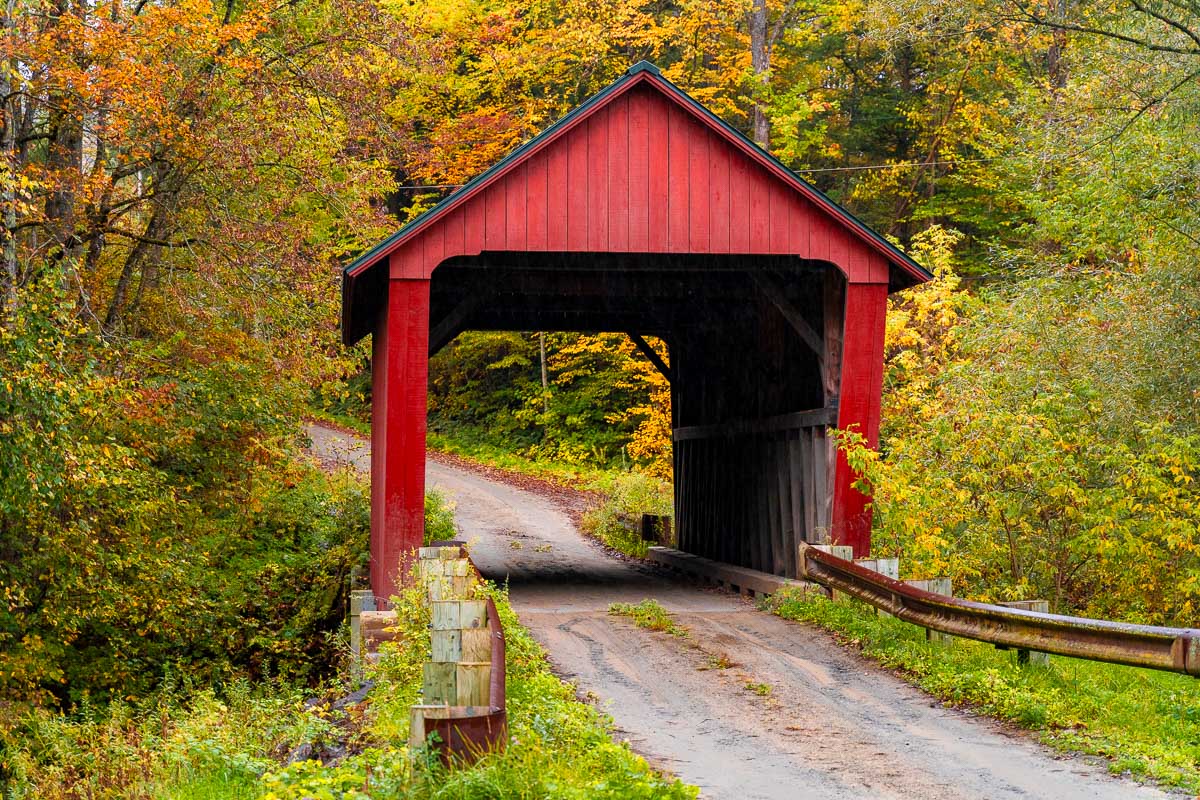
16. Creamery Covered Bridge, Brattleboro VT
The Creamery Covered Bridge is situated a 5-minute drive west of Brattleboro, a border town on the western banks of the Connecticut River that links Vermont with New Hampshire. The bridge stretches across the winding Whetstone Brook.
Built in 1879 out of spruce lumber, the Creamery Covered Bridge is Brattleboro’s last surviving 19th-century covered bridge.
What marks this one out against the rest of the covered bridges in Vermont featured in my guide is that it is now closed to automobiles and only pedestrians are permitted to cross it.
When you visit you will see that there is a larger track that was formerly used by road traffic and a separate path for pedestrians that was added in 1920.
Once you’ve parked your car, you can wander through the bridge on foot and enjoy taking photos without having to think about cropping vehicles out of your pictures later.
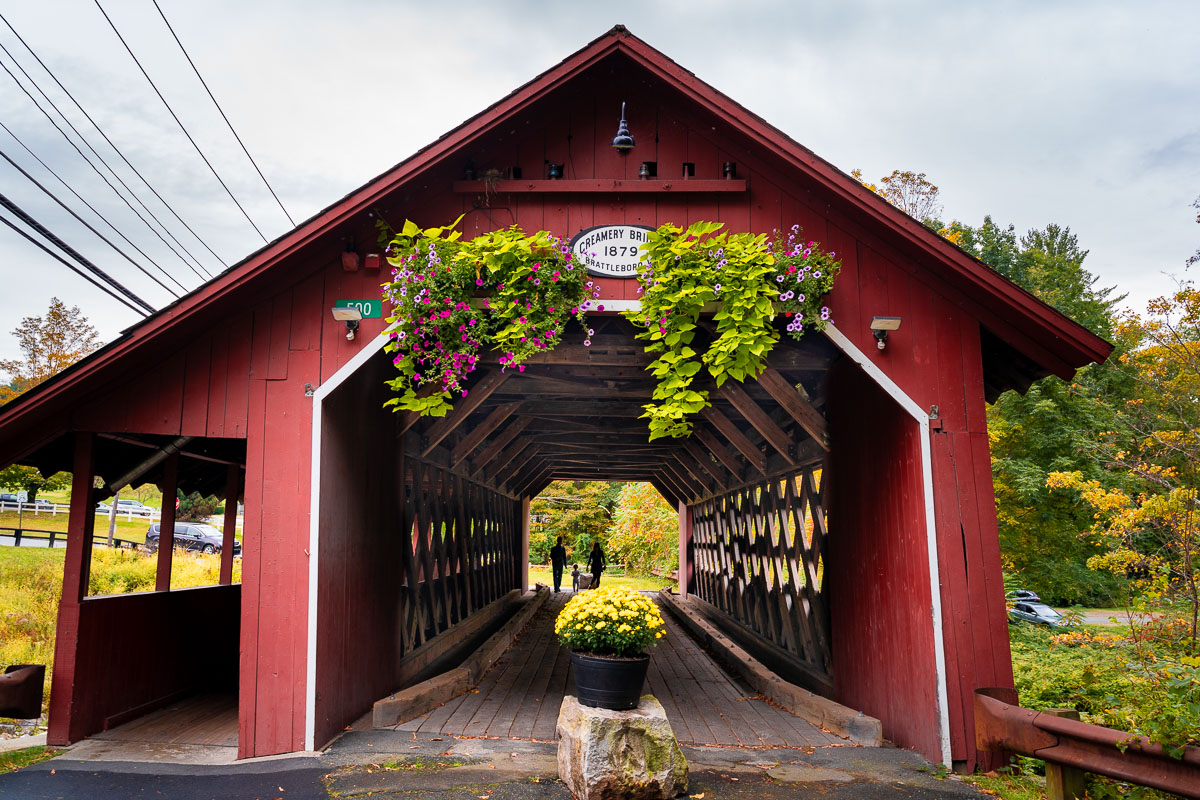
Best Covered Bridges in Vermont on the Map
Below you can find a customized map that includes all the best covered bridges in Vermont mentioned in this article.
How to use this map: This map is fully interactive, so you can move around, zoom in/zoom out, and click on the icons. If you want to see a larger map, click on the bracket in the upper right corner. To see more details and the different layers, click on the tab in the upper left corner. If you want to save it for later, click on the star icon next to the name of the map. Then simply open Google Maps either on your desktop or phone, go to ‘Saved’/’Maps’, and open the map whenever you need it.
Planning a trip to New England?
Then you might want to take a look at all our other travel guides about New England. I promise, they are just as awesome as this article was!
Vermont:
- The Perfect New England Fall Road Trip for 2 Weeks
- Vermont in the Fall: Travel Tips & Best Places to Visit
- 16 Incredible Things to Do in Woodstock VT
- 17 Amazing Things to Do in Stowe, Vermont
- 17 Incredible Covered Bridges in Vermont You Need to Visit
New Hampshire:
Massachusetts:
- How to Spend One Day in Boston: Itinerary & Best Things to Do
- 13 Best Day Trips from Boston You Can’t Miss
- Where to Stay in Boston: 8 Best Areas & Hotels
- 19 Spooky Things to Do in Salem MA in October
Maine:
- How to Spend One Day in Acadia National Park
- The Perfect 2 Days in Acadia National Park Itinerary
- Acadia National Park in the Fall: Practical Info & Tips for Visiting
- How to Spend One Day in Portland, Maine
- 5 Prettiest Lighthouses in Portland Maine You Can’t Miss
Pin It for Later!
